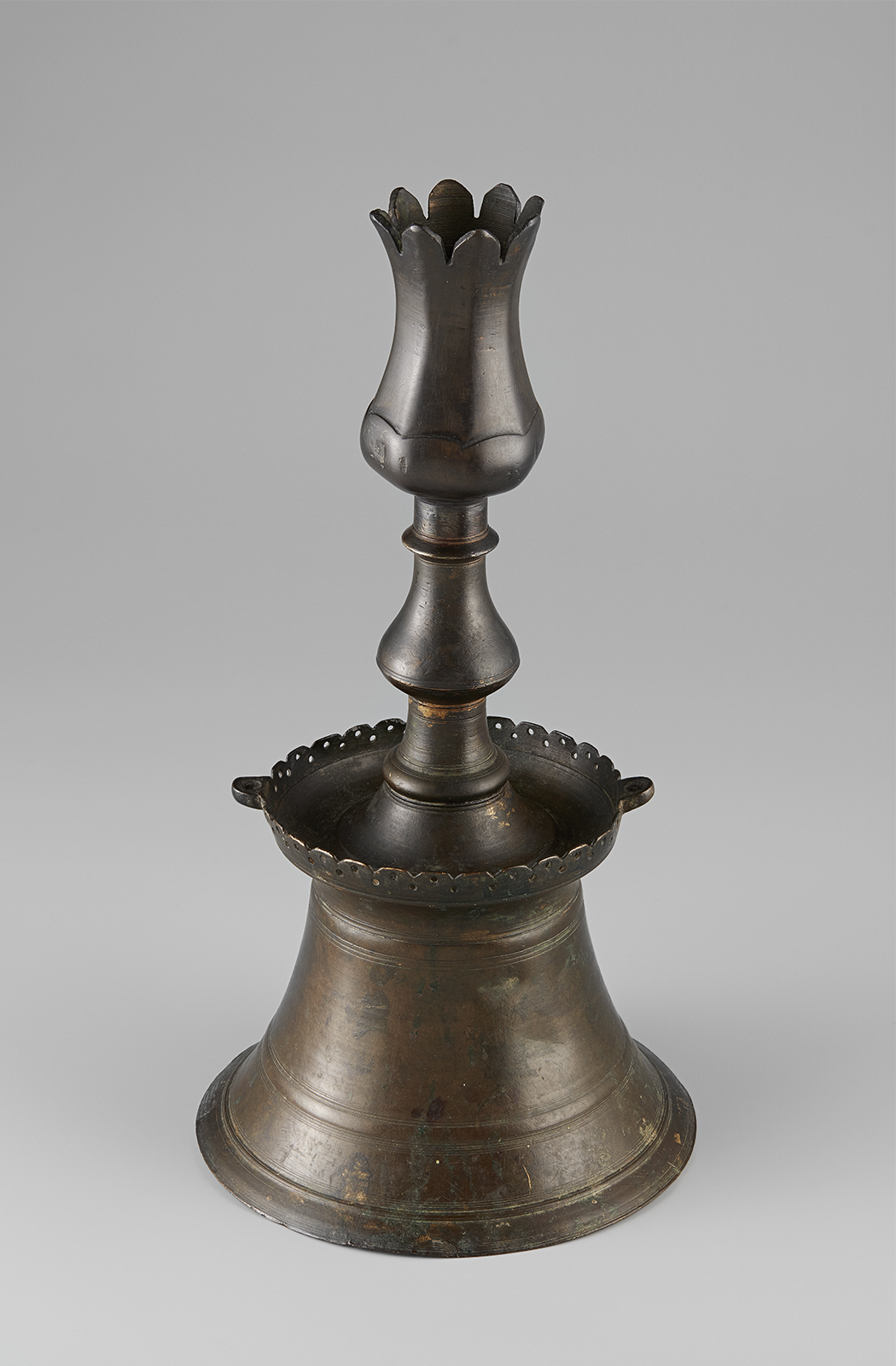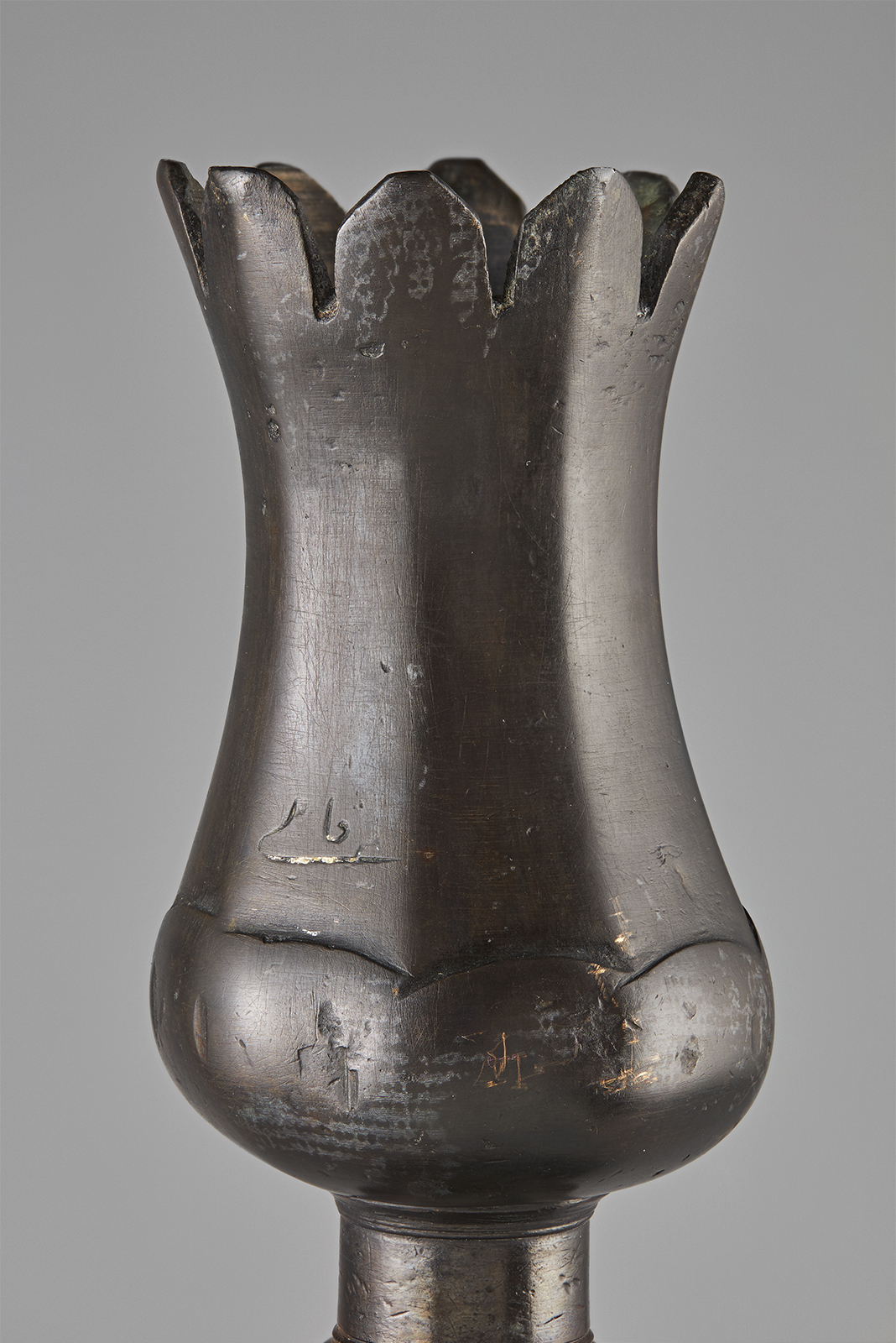Click on the image to zoom
Candlestick
- Accession Number:2017.2.1
- Place:Turkey
- Dimensions:Height 31.5 cm
- Date:early 16th century
- Materials and Technique:Brass
During the long history of the Ottomans, the reigns of Sultans Selim I (1512–20) and Suleyman the Magnificent (1520–66) stand out and featured many significant changes. Both rulers challenged neighbouring nations with aggressive expansion of the Ottoman borders, adding vassals to the empire in the east and west. To celebrate their far-reaching power, the sultans commissioned cultural, architectural, and artistic projects throughout their domains. Notably, during the reign of Suleyman, a fondness for sumptuous, bejewelled metals was cultivated. In addition to this fascination with luxurious works of art, interest arose in the so-called plain style, one of the new modes introduced during this time. [1]
Further Reading
The plain style applied to metalwork showcased the masterful ability of Ottoman artisans to focus on the form of vessels while avoiding ornament and decoration on occasion, as represented in the candlestick here. The body of this candlestick has a graceful, bell-footed appearance complemented by a budding tulip-shaped candleholder.[2] Its bulbous neck has two rings, and the candlestick displays remnants of gilding.
The tulip as a model or inspiration for shaping candleholders is not unusual or surprising, considering the great love for horticulture in Ottoman society. In fact, in the sixteenth century, Istanbul boasted more than two hundred flower shops.[3] As an original steppe flower of Central Asia, the tulip had a long tradition in Anatolia as reflected in Saljuq art, but its prominence and prestigious status truly blossomed under the Ottomans. By themselves or in combination with cloves and roses, tulips were highly appreciated as one of the chief floral motifs in Ottoman decorative art.
An almost identical candlestick in the Los Angeles County Museum of Art bears an inscription with a date of execution of AH 905/1499–1500.[4] Further examples with some variations are found in international collections and support the dating of these plain candlesticks to the sixteenth century.[5]
— Filiz Çakır Phillip
Notes
[1] For plain style, see Yanni Petsopoulos, ed., Tulips, Arabesques & Turbans: Decorative Arts from the Ottoman Empire (London: Alexandria Press, 1982).
[2] The bell-footed candlestick has a long tradition in Iran, Anatolia, and the Jazira.
[3] Nurhan Atasoy, A Garden for the Sultan: Gardens and Flowers in the Ottoman Culture, Robert Bragner and Angela Roome, trans. (Istanbul: Kitap Yayinevi, 2011), 11; Filiz Çakır Phillip, ed. Arts of the East: Highlights of Islamic Art from the Bruschettini Collection (Toronto/Munich: Aga Khan Museum/Hirmer Verlag, 2017), 40.
[4] Los Angeles County Museum of Art, M.2002.1.12. See Linda Komaroff, Beauty and Identity: Islamic Art from the Los Angeles County Museum of Art (Los Angeles: Los Angeles County Museum of Art, 2016), accessed May 7, 2018, at https://collections.lacma.org/node/187812; Christie’s, Arts & Textiles of the Islamic & Indian Worlds, London, South Kensington, April 28, 2017, Lot. 213.
[5] National Museum of Hungary, Budapest, Ottoman copper candlestick with fish motifs on the foot of a bell-footed body, dated sixteenth to seventeenth centuries, brought to the museum by the Roman Catholic Church at Liptoszentandras, Inv. No. 1917.23.B; Geza Feher, Türkisches und Balkanisches Kunsthandwerk (Corvina, Hungary: Helikon, 1975), 40, pl. 73.; Victoria and Albert Museum, Candlestick,Turkey, 16th century, Inv. No. 931-1884, http://collections.vam.ac.uk/item/O85349/candlestick-unknown/
References
Petsopoulos, Yanni, ed. Tulips, Arabesques & Turbans: Decorative Arts from the Ottoman Empire. London: Alexandria Press, 1982. ISBN: 9780856671517
Atasoy, Nurhan. A Garden for the Sultan: Gardens and Flowers in the Ottoman Culture. Translated by Robert Bragner and Angela Roome. Istanbul: Kitap Yayinevi, 2011. ISBN: 9789757710103
Çakır Phillip, Filiz, ed. Arts of the East: Highlights of Islamic Art from the Bruschettini Collection. Toronto and Munich: Aga Khan Museum/Hirmer, 2017. ISBN: 9783777429649
Komaroff, Linda. Beauty and Identity: Islamic Art from the Los Angeles County Museum of Art. Los Angeles: Los Angeles County Museum of Art, 2016. ISBN: 9781943042036
Feher, Geza. Türkisches und Balkanisches Kunsthandwerk. Corvina, Hungary: Helikon, 1975. ISBN: 9789631344622
Note: This online resource is reviewed and updated on an ongoing basis. We are committed to improving this information and will revise and update knowledge about this object as it becomes available.




